The Ultimate 6 Day Banff Itinerary
**Disclosure: Bear in mind that some of the links in this post are affiliate links and if you go through them to make a booking I will earn a commission. I link these websites because they have the best price and not because of the commission I receive from your purchases. The decision is yours, and whether or not you decide to make a booking is completely up to you. I only recommend websites I use myself and I know will be beneficial for my readers!
The Canadian Rockies is an INCREDIBLE ice-capped mountain range that stretches through British Columbia and Alberta. It is one of the most beautiful places on earth! The below 6 day Banff itinerary will have you seeing turquoise-coloured glacier lakes, towering waterfalls, picturesque mountains, glacier and ice fields, lush forests, and abundant wildlife.
This 6 day Banff itinerary includes must-visit places, hidden gems and everything you need to know about Banff.
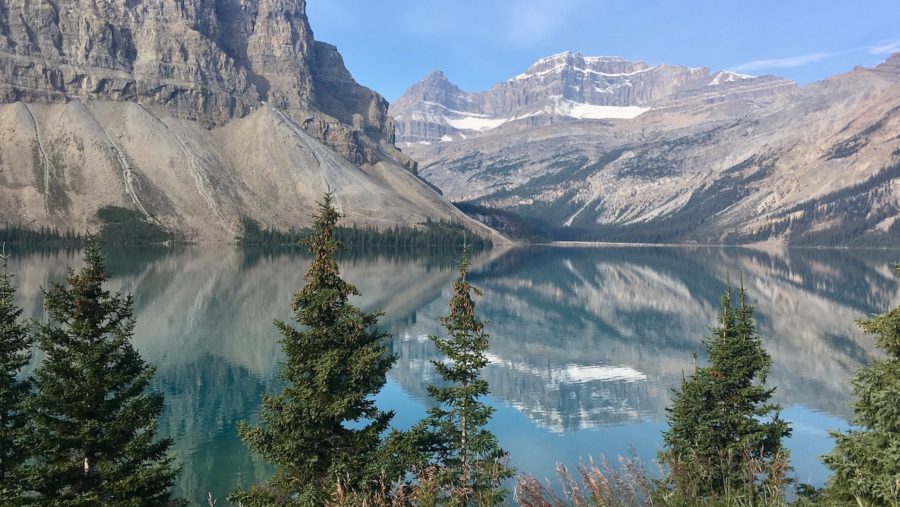
The Best Time to Visit Banff
The peak season is the summer months from June to September. This is the best time to visit because the weather is warmer, the roads are clear and all the hiking trails are open. The turquoise and aqua colours of the lakes are also the most intense during the summer months.
Banff during peak season can get very busy and accommodation is generally more expensive as expected. Make sure to plan ahead and book accommodation in advance.
September is the best month to visit Banff because the weather is generally sunny, there are fewer tourists and the lakes are at their best colours.
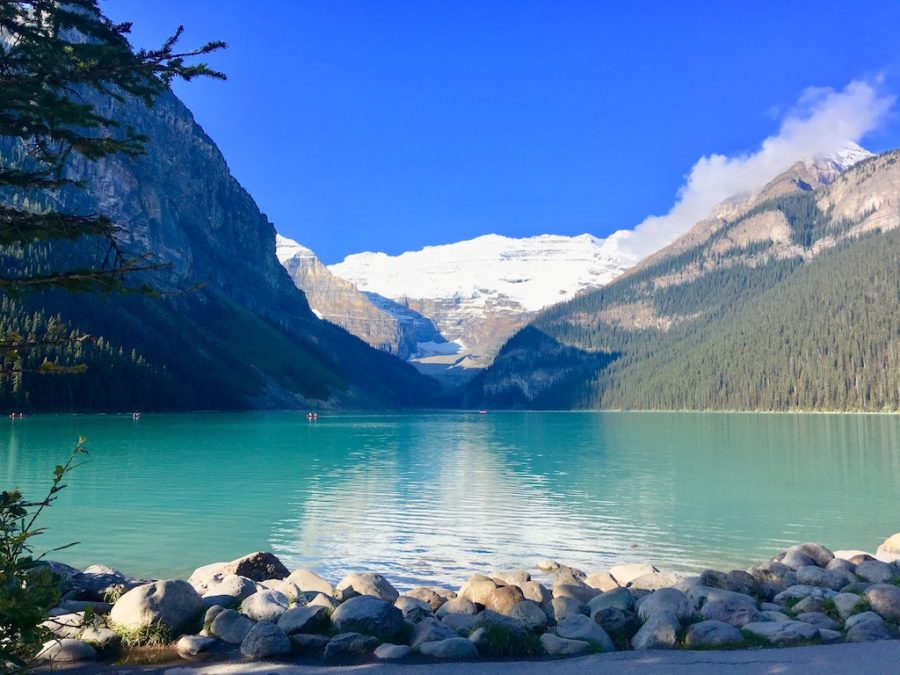
No matter what season of the year you visit, Banff is a magical place. In the winter, it’s transformed into a winter wonderland! Keep in mind that Moraine Lake is closed for the winter season and most of the other lakes will be frozen.
Lake Louise is transformed into a skating rink with the most stunning background of ice-capped mountains. Some hiking trails and roads will also be closed for safety reasons. If you travel to Banff in winter make sure your car has winter tires as it’s mandatory.
How to get to Banff
On my first trip to Banff I joined a tour (which I recommend doing if you’re travelling solo), twice I did a road trip from Vancouver and the other two times I flew from Vancouver to Calgary and then took a greyhound bus from there.
Doing a road trip is the best way to get to Banff! There are many beautiful places to see along the way and the drive to and through the Canadian Rockies is AMAZING!
If you don’t have enough time to do a road trip then flying to Calgary Airport is the easiest and quickest way to get to Banff. From Calgary Airport you can either hire a car (which I recommend as it gives you the freedom to do what you want) or you can catch a bus to Banff. Most hotels will have shuttle buses that take you to the main tourist destinations.
Accommodation in Banff
If you’re on a budget or travelling solo the best hostel in Banff to stay at is Samesun Backpackers. It’s cheap, clean, and in a convenient location!
Even if you’re not staying at the hostel you should visit their Beaver Bar! If you’re an Aussie you will be psyched to know that they do Jam Doughnut shots here! Try their delicious Agwa Bomb drinks and take shots with your friends from a snowboard!
Banff can be a pretty expensive place to stay but you can find good deals. The best website to book your accommodation in Banff is Agoda where you can filter to your needs and budget.
Park Pass
You will need to purchase a Park Pass when visiting any National Park in the Canadian Rockies. There are booths along the highway and at park entrances or you can go online to purchase.
Day passes are valid until 4 pm on the day of purchase however if you are visiting parks for multiple days then the Discover Pass is the best value and is valid for a whole year until the end of the calendar month of purchase.
You will only need to purchase one pass to provide you entry into many National Parks including Banff, Jasper, and Yoho.
6 Day Banff Itinerary
Day 1 – Lake Minnewanka, Cascade Falls and Johnston Canyon
There is no better way to start the morning and your Banff trip than at a peaceful lake 10 minutes away from Banff town.
Lake Minnewanka
Lake Minnewanka is one of many glacier-fed lakes in Banff. It’s the second-longest lake in the Canadian Rockies at a length of 21 km long.
This still clear lake reflects the mountains perfectly as you can see in the below photo.
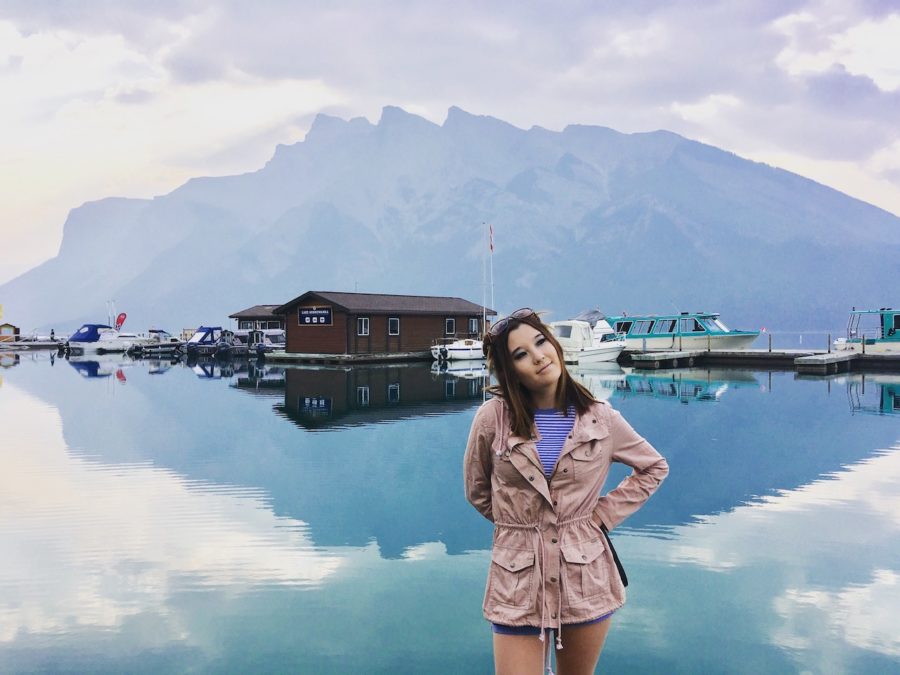
Lake Minnewanka is a great place for a picnic, to do some hiking and canoeing.
Cascade Falls
Not far from Lake Minnewanka is Cascade Falls the third largest waterfall in Alberta at around 290 m tall. It can easily be seen from the TransCanada Highway 1.
As you drive back towards the TransCanada Highway 1 exit pull off the road at the dirt parking area on the right. The parking area is not marked but there is a sign for Cascade Lakes on the opposite of the road. From the parking area walk across the grassy field toward the waterfall.
The trail up to the waterfall is very steep in parts but reaching the base of the falls is achievable for most people. If you want to continue climbing up be careful because the rocks are slippery!
The waterfall is impressive and if you do keep climbing up higher you will get awesome views of the valley and surrounding mountains.

Johnston Canyon
Johnston Canyon is a popular tourist national park with hiking trails to waterfalls, ridges, and blue inkpot spring pools. No matter what season you visit I can guarantee it’s going to be busy so your best bet is to go early in the morning or late in the afternoon.
The Lower Falls is 1.1 km from the start of the trailhead and will take you around 30 minutes. It’s a fairly easy walk with a bridge at the end to cross over the creek where you will get a first glimpse of the falls. Keep walking across the bridge to the short dark tunnel through the canyon bedrock to get closer.

The Upper Falls trail continues through the canyon across bridges and along the creek. The 2.6 km trail to the Upper Canyon Falls takes about an hour. It’s not a hard trail with mild elevation gain through the canyon. If you plan on doing both the Lower and Upper Falls allow around 2-3 hours return trip.
The trail to the ink pots is a longer hike and from the Upper Falls will take around 1 hour. It’s a perfect place for some solitude. The trail starts past the Upper Falls and continues into the forest for 3 km. The ink pots are several pools of greenish-coloured mineral springs!
Day 2 – Lake Louise, Moraine Lake and Banff Upper Hot Springs
Lake Louise
Lake Louise is the most famous tourist destination in Banff and is the reason many people come to visit Banff!
It does get very busy at Lake Louise so keep in mind that you won’t be having this lake all to yourself although I am sure you will find a small spot along the lake where you can take photos without anyone in them.
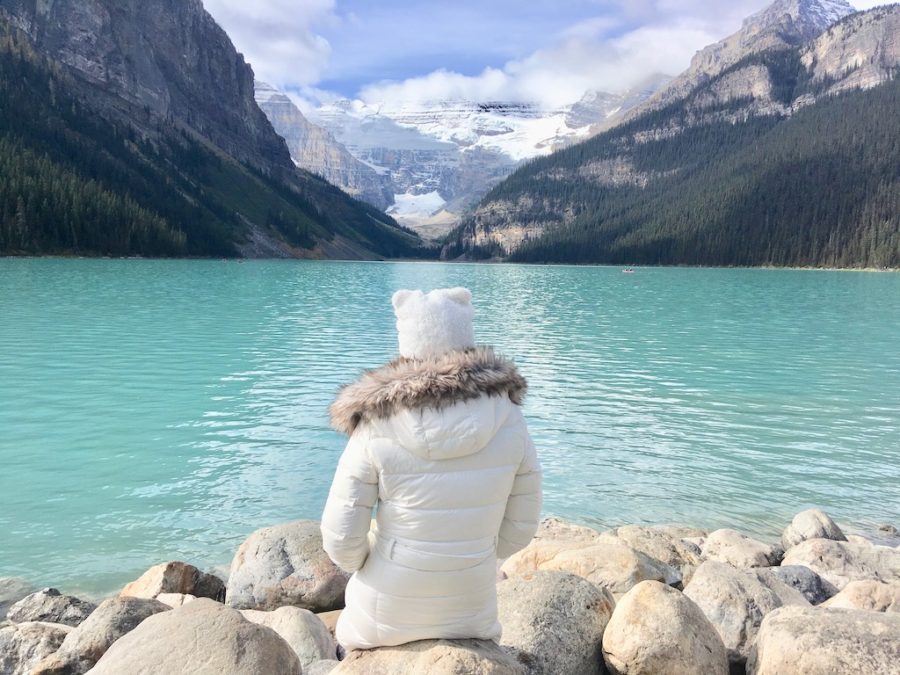
Try to get there early to get a parking spot. If the parking lot closest to Lake Louise is full there is an overflow parking lot and a FREE shuttle bus from there to Lake Louise.
Take a canoe out on this insanely beautiful glacier-fed lake or hike up the mountain for incredible views or you can do both depending on how much time you have here.
As you walk past the Fairmont Chateau Hotel along Lake Louise you will see a trailhead that begins to Lake Agnes. This steep hike is about 7.6 km ascending up the mountain. It offers fantastic views of Lake Louise from up high and the trail leads to another beautiful lake with an incredible backdrop of the mountains.

Once you reach Lake Agnes make sure to visit the oldest Tea House in Canada. The Tea House is open from early June through to October. Keep in mind that they only accept cash.
Continue on the trail past the Tea House and Lake Agnes to the Little Beehive and/or Big Beehive for more impressive views.
Moraine Lake
Close by Lake Louise is Moraine Lake a lake with deep blue waters surrounded by the Valley of Ten Peaks. You can see Moraine Lake from the parking lot but for the best view take the trail up the rock pile.
The rock pile trail is an easy and short walk to the top of the rocky moraine and provides views over the lake with the mountains as its backdrop. At this viewpoint, it’s known as the “Twenty Dollar View” only because this scene is featured on the back of twenty dollar notes that were issued between 1969 and 1979. It’s more like a Million Dollar View!
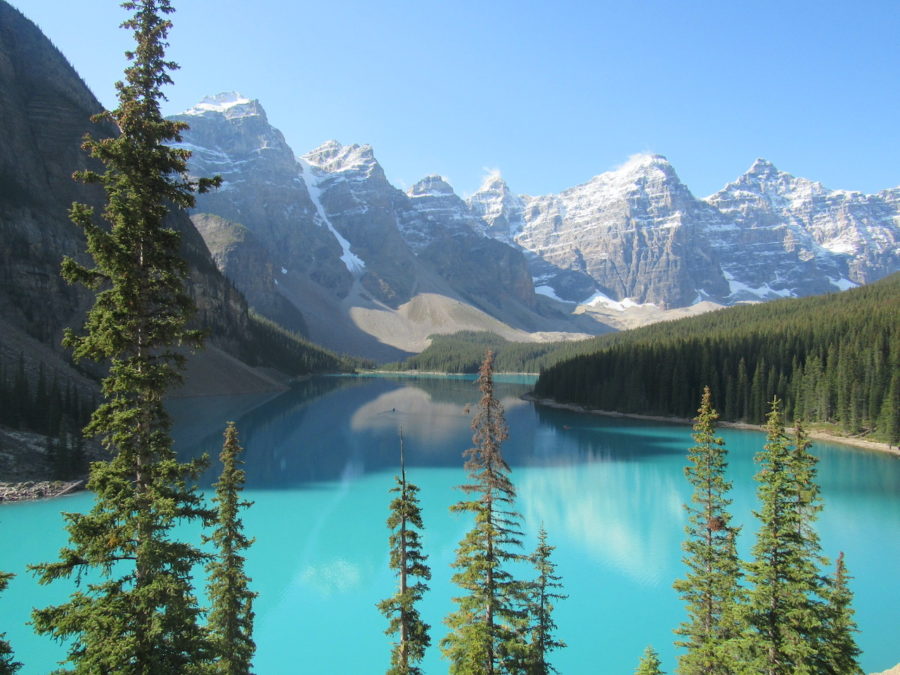
The road to Moraine Lake is closed during winter so you will need to visit between June to October. When planning your Banff trip reserve a Parks Canada Shuttle ahead of time as parking is limited.
Banff Upper Hot Springs
After a day of physical activity soak in the hot springs with a view of the surrounding snow-capped mountains. The soothing minerals in the hot spring will for sure relax your muscles and joints.
Banff Upper Hot Springs is located near the top of Sulphur Mountain and 10 minutes away from town. It does get extremely busy during peak times and seasons.
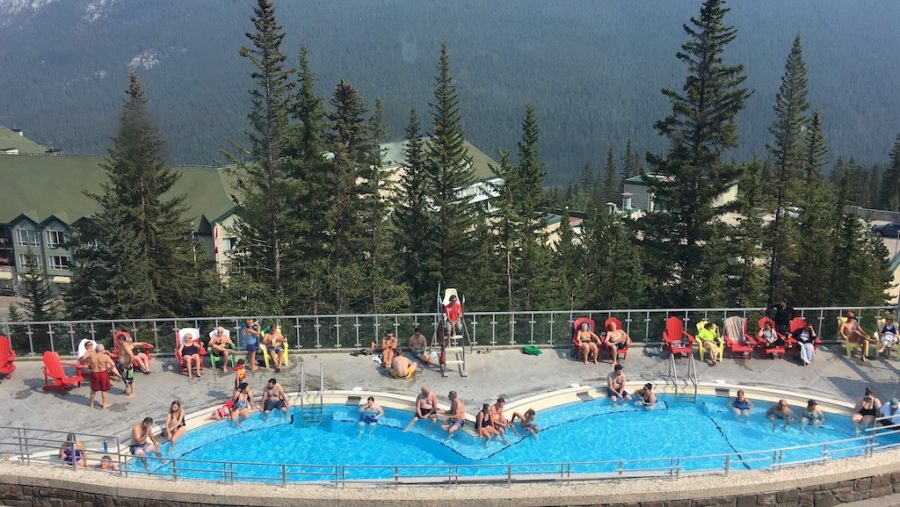
Admission into the hot springs is a small cost of $8.48 and an additional $2 to rent a towel. The hot springs are open from 10 am – 10 pm and the best time to visit is in the late afternoon/evening.
Day 3 – Yoho National Park (Emerald Lake, The Natural Bridge, and Takakkaw Falls)
Yoho National Park is often missed by many first-time visitors as they focus on visiting popular famous touristy places in Banff. It’s just as beautiful if not more beautiful than the other parks listed in this 6 day Banff itinerary.
Emerald Lake
Emerald Lake is the largest lake out of the 61 lakes in Yoho National Park. It’s a peaceful emerald green lake surrounded by lush forest and towering mountains.
Although not as popular as Moraine Lake or Lake Louise, Emerald Lake is not one to be missed!

Canoe rentals are available at Emerald Lake and there are also hiking and walking trails around. The loop trail around the lake is a pleasant walk and I suggest doing this while you are visiting.
Emerald Lake Lodge is the place to stay if it’s within your budget means. If you want luxury then stay in Point Cabin a suite with a whirlpool bath, a wood-burning fireplace, and a balcony with premier views of Emerald Lake.
The Natural Bridge
The Natural Bridge is a natural rock formation over the Kicking Horse River and can be found along the same highway leading from the Trans-Canada Highway turn-off to Emerald Lake.
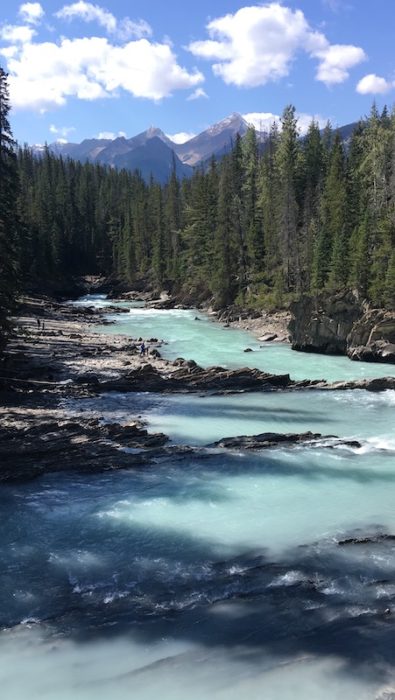
The unique rock resembles a bridge and you don’t have to walk very far from the parking lot to see it.
Takakkaw Falls
Takakkaw Falls is the second-highest waterfall in Canada at 384 m.
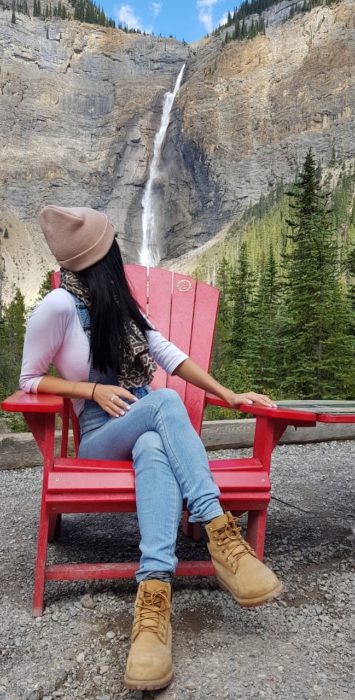
To see this magnificent waterfall it’s an easy walk along a well-maintained pathway from the parking lot and across a wooden bridge. Takakkaw Falls plunges at high speeds of the cliff wall, it’s an incredible sight to see!
The trail to the falls is located on Yoho Valley Road and keep in mind that this road is only open from late June to mid-October.
Day 4 – Icefields Parkway (Bow Lake and Peyto Lake)
The Icefields Parkway is the road that connects the two Canadian national parks, Lake Louise and Jasper. It’s one of the most SCENIC roads to drive on in Alberta. On the Icefields Parkway, you will see rocky mountains, ice fields, and vast valleys.
Bow Lake
Bow Lake is approximately 30 minutes north of Lake Louise off the Icefields Parkway. It’s one of the largest lakes in Banff National Park! Bow Lake lies at the base of Bow Summit and the glacier waters are fed from Bow Glacier in the Wapta Icefield.
It is not as popular as Lake Louise or Moraine Lake but it is just as amazing!
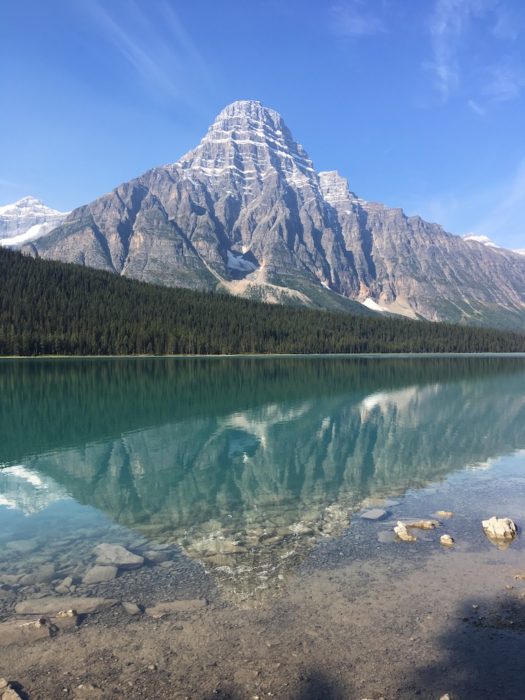
Peyto Lake
Peyto Lake is my favourite lake in the Canadian Rockies! The aqua colour of the lake is created by the water melting from the Wapta Glacier.
Hike the Panorama Overlook an easy 2.7 km roundtrip hike for the best viewpoint!

Access to the trail is just off the Icefields Parkway and there are signs to guide you. The trail brings you to a breathtaking viewpoint of Peyto Lake from above where you have a panoramic view of the entire lake.
Day 5 – Icefields Parkway (Panther Falls and Parker Ridge Trail)
Panther Falls
Panther Falls is a hidden gem that you would only find by researching it. The easiest and quickest way to get to Panther Falls is by starting from the Bridal Veil Falls parking lot along Icefields Pathway.
Bridal Veil Falls can be seen from the parking lot whereas you will need to walk through the forest to view Panther Falls.
From the far south corner of the parking lot walk along the road and you will soon come to a sign at the edge of the forest. The trail is a narrow zig-zag 1.3 km walk and will take around 30-40 minutes.
Parker Ridge Trail
Parker Ridge Trail is a 5.1 km steep hike up a mountain but the view is worth the hard work getting there! At the top of the mountain, you get unforgettable views of the Saskatchewan Glacier flowing out from the Columbia Icefield. Saskatchewan Glacier is the largest of the Columbia Icefield’s six valley glaciers.
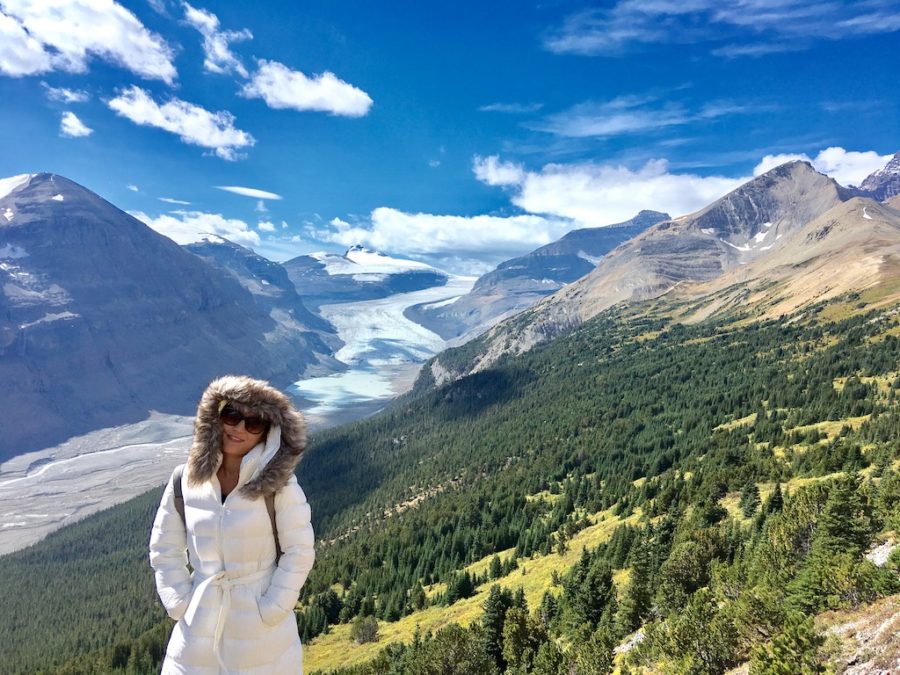
I would allow 2-3 hours roundtrip for this trail. You’re going to want to stay up there for a while to enjoy the spectacular views!
Day 6 – Jasper National Park (Athabasca Glacier, Tangle Creek Falls, and Athabasca Falls)
Jasper National Park is the largest national park in the Canadian Rockies extending over 11,000 square km. The below places to visit are at the start of Jasper National Park and a touch of what there is to see and do in Jasper.
Athabasca Glacier
Athabasca Glacier is one of the most accessible glaciers in the world. It’s is 6 km long and 1 km wide and is within walking distance of the Icefields Parkway.
If you want an even closer view of the glacier than from the parkway you can purchase tickets to ride the Ice Explorer Adventure a 6 wheeled truck that takes you onto the glacier. These vehicles are specially designed for glacier travel.
Once they bring you onto the glacier you are free to walk around standing on ice that is thousands of years old.

The ticket to the Columbia Icefield Glacier Adventure includes admission onto the Glacier Skywalk. The Glacier Skywalk is a glass platform hanging from the cliff edge and looking out towards the Sunwapta Valley.
Tickets can be purchased online or at The Discovery Center where the shuttle bus departs to the two attractions.
If you don’t want to purchase tickets then you can drive to the base, park, and walk for 10 minutes to get close to the foot of the glacier.
Tangle Creek Falls
Tangle Creek Falls is located on the Iconic Icefields Parkway 16 minutes from Athabasca Glacier and very close to the road. The parking area is situated across the road from the falls. Be careful when crossing the Icefields Parkway.
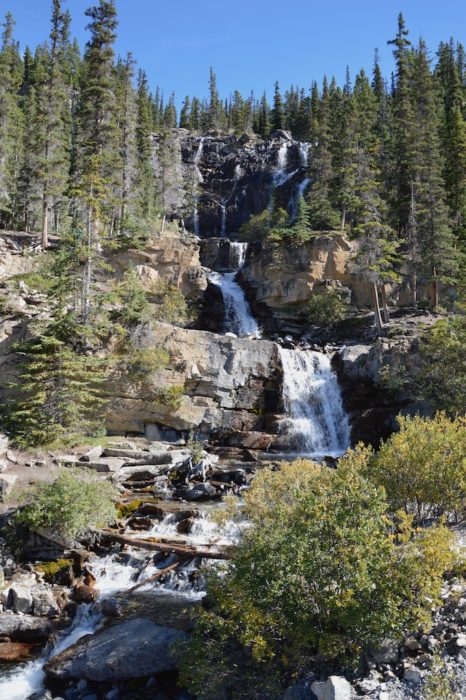
Climb up the side of the multi-tiered waterfall for about 15 minutes to awesome views of the valley!
Athabasca Falls
Athabasca Falls is considered to be the most powerful waterfall in the Canadian Rockies! These powerful falls flow into the gorge from the Athabasca River fed by Columbia Icefield. It’s a 45-minute drive from Tangle Creek Falls so I would only visit here if you have time.

Walk along the 1 km interpretive trail and take in the sights of the Athabasca river and waterfall. There are many viewing platforms for safe viewing and photo taking.
Banff is a trip for families, couples, solo travellers, budget travellers, luxury travellers literally anyone because it’s affordable, beautiful, and like no place on earth! It is the best place for outdoor activities such as hiking, skiing, snowboarding, snowshoeing, canoeing, kayaking, and much more.
There are many places to explore in Banff and it can make your trip planning overwhelming. I hope that the above 6 day Banff itinerary will help save some time when planning your trip there.
like this website? Get it on thestartupmarket.com
T & C'S
privacy policy
contact
customised Itineraries
shop
blog
about